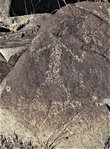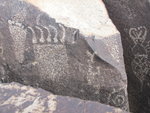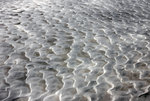Wind: 10.4 mph, W
Welcome to our new web site!
To give our readers a chance to experience all that our new website has to offer, we have made all content freely avaiable, through October 1, 2018.
During this time, print and digital subscribers will not need to log in to view our stories or e-editions.





An archaeological crew at the southern end of the Alamogordo landfill was baking under the dry heat in the few weeks before the moisture-laden monsoon in the Tularosa Basin arrived.
“It was going to hit 106 degrees and we hit a solidified layer some 1.2 meters below the surface deep under the shifting sand dunes into an ancient lakebed,” said Lay Powell, an artist and novice crew member. “I kept pulling sand away looking for artifacts or even ruins. It was weird – I thought I better use a brush.
“I was thinking there might be animal tracks or maybe like a deer and then there was a digit, like a finger. I brushed a second digit next to it, then a third digit. My heart started to beat so fast … What really came to mind when I looked across to the east, I could almost see MacNeish’s cave. That is how rapidly I connected to Pendejo Cave, I automatically thought of Paleoindian peoples 10,000 years ago. “
“Scotty” MacNeish, one of the most famous and controversial archaeologists ever in the Tularosa Basin, searched for the earliest evidence of human occupation. Thirty years ago, MacNeish “held up a hardened clay fragment from the side of a cooking pit in a cave (30,000 years old) with a fingerprint” to reporter Phil McCombs for the Washington Post, an invaluable treasure in his life of encountering the primal experiences so rare in today’s urbanized world.
Knots for nets for carrying large containers or capturing lake fish, turtles and birds were found by the hundreds by MacNeish. His cave was a production site overlooking the lakes.
“Her palm print… baked into the clay of the paleolithic fire pit,” writes McCombs at a cave site overlooking the southern Tularosa Basin.
Now, footprints emerged. Ultimately, two more prints of the same person going south and one print going north were uncovered by Four Corners Research based in Las Cruces that are dated from 7,000 to 9,000 years old, either late Paleoindian or middle Archaic eras, said David Greenwald, director of Four Corners. It was clear that the prints came after the clay surface of the lakebed began to dry out. When the feet sank near the cracks, there was a mushing up of still wet clay to ooze around the traveler, Greenwald notes.
These people traveled during cycles of expanding and contacting edges of the shallow lakes in tandem with the Pacific Ocean cycles of what we call the El Nino-La Nina. Ten thousand years later, humans recorded their precious feet and hands along with those of their animal associates on petroglyphs at Three Rivers Petroglyph Site, only few miles northeast of the sand dunes. Human prints interact with birds, bear and felines to an astonishing amount, realistic or out-of-the ordinary looking to us. Tracks were dominant symbols of the perceptions of reality of prehistoric life in the Basin.
The everchanging dunes at White Sands National Park cover and uncover an even greater story of Paleoindian lifetimes. Biologist David Bustos, with over 15 years of experience at WSNP, has attracted numerous scientists to measure not only the ephemeral dunes transforming under wind and water dynamics but ancient footprints solidified in the once muddy mix of the shallow playa lakes.
Human footprints small enough to fit neatly inside the deep prints of a now extinct giant ground sloth tell Bustos and others that humans used sloth prints as steppingstones in their interaction with the sloth. Sometimes the humans were on top, sometimes the sloths were on top. They were circling each other -- this opens up a whole new class of behavior data for the Paleoindian sites that can be studied at the national park of ancient glistening sands. Now, the national park is designing an Ice Age Trail with informational plaques to share their extensive finds with the public.
The sodden earth of 7,000 to 9,000 years ago that eventually dried out in the Tularosa Basin recorded prints of the hardened feet of human passage on trails carrying people with skilled abilities to make and thrust ancient lithic tools for killing animals, tools to harvest reeds for weaving water-tight baskets, crafting stones for grinding numerous types of seeds, tools to cut thick hides or wood of appropriate diameter for shelters.
Each new tool was a technological invention with all the lifestyles adjustments that evolved from it, says Lisa Sparks, a lithics expert, archaeologist and teacher. The women are now thought to have the same skills as the men in communities that spanned the basin from summer to winter. In the small family groups, a tool like an obsidian blade sharp enough to perform surgery was a family heirloom, a possession that was highly valued and cared for, though perhaps traded as well.
The communities of so long ago did not have much to throw away. Everything was hand made of organic materials that return into landscapes of memory. Rare beautifully crafted basketry, painted pottery worth thousands of dollars today, stone tools such as obsidian that are so sharp they can be and were used for internal surgeries can be found and have often disappeared into private collections.
Joe Lowendowski wears two hats that are strangely intertwined. He used to manage solid waste fill sites for municipalities. He also designs and mounts exhibits for the local Tularosa Basin Historical Museum. Now a consultant for the Alamogordo landfill, Lowendowski knows that today’s throwaway plastics will be the focus of tomorrow’s archaeology-plastic will last for hundreds of years.
The city of Alamogordo purchased 628 acres from the State Land Office with 18 possible locations at that time. The process of opening new land to be used for more landfill needs takes years. Lowendowski has shepherded the permitting process through the halls of the environmental protection division and state cultural resources agencies.
“The odds of discovering an ancient human footprint in a one meter grid unit among thousands of acres in the Tularosa Basin, still I think I might be dreaming. It was surreal,” Powell mused.
Under the shifting sands ever responding to the forces of wind and water dynamics is evidence of the earliest human perceptions. We can only try to follow in their tracks to share their great picture of a world of permanence and impermanence.